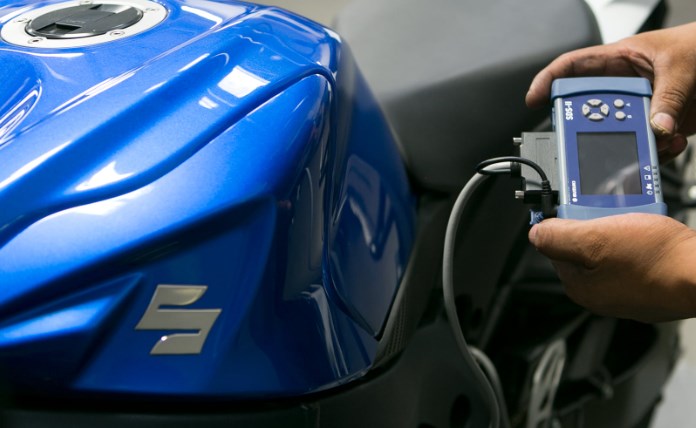
Home > general information > Tips and Guides > Technical guides > Generalists >
The environmental standard Euro 5+ is coming!
Long late par compared to cars in terms of regulating polluting emissions (the latter having already passed theEuro 6), two-wheelers have tended to reduce this gap in recent years thanks to the introduction ofEuro 4 in 2016 as well asEuro 5 in 2021.
A new boost will be given from January 1, 2024 with the deployment of the standard Euro 5+. This development provides, among other things, for a revision of durability tests, reinforced diagnostics and a stricter level of noise emissions.
What is the standard Euro ?
The European Commission is at the origin of European emission standards, more commonly called “standards”. Euro HAS". The aim of these standards is to control the rate of polluting emissions from all vehicles, and to reduce it a little more each time. Contrary to what one might think at first glance, carbon dioxide (CO2) is not one of the controlled pollutants since it exists naturally in the atmosphere. Thus, the polluting gases concerned par the norm are hydrocarbons (HC), nitrogen oxides (NOx), carbon monoxide (CO) and microparticles (MP).
The induced constraints par European emission standards mean that all road transport tends towards minimum pollution. That said, they also act as an accelerator of new technologies, which are therefore more efficient.ar consuming less. But this also causes some constraints for motorcyclists, particularly when it comes to driving in the city center. Restricted traffic zones (ZCR) are toughening up with mandatory Crit'air stickers and extending to all major French cities.
A little reminder about theEuro 5
In line with theEuro 4, the norm Euro 5 is part of a desire to reduce noise and the environmental impact of two-wheelers.
3 big changes to note following the transition toEuro In 5:
- a drop in sound
- an increase in engine capacity
- an increase in prices
This last point is explained byar the fact that some engines cannot be reworked to satisfy theEuro 5 without the cost being too high for manufacturers and only versions equipped with ABS are still offered.
Regarding its application, it becomes mandatory for all motorized two-wheelers approved after January 1, 2020 or on January 1, 2021 for those approved before. A period of 4 years was granted to enduros and trial, utility three-wheelers and light quadricycles up to 2024.
What changes with the standard Euro 5+?
In terms of controlling polluting emissions, to tell the truth, not much. It is not a new standard that awaits manufacturers but rather an update of the standard Euro 5. On the other hand, it will introduce new criteria for on-board diagnostic devices, durability tests and sound tests. The idea here is to ensure that polluting emission levels do not exceed the authorized limit both when the motorcycle is new and later.
To do this, the catalyst durability test must no longer be based on a calculation of deterioration, but on taking real data on the road or track. So, Euro 5+ introduces a new phase of OBD II on-board diagnostics with more stringent engine emissions durability testing and additional noise reductions. However, this risks causing problems for certain entry-level systems which today pass the accuracy standard and which mathematical calculations could save.
The OBD II on-board diagnostic tool will no longer be content with checking the correct connection of the sensors and the consistency of the data collected, but will also have to monitor the catalyst, the sensors oxygen or even combustion misfires. A verification frequency is introduced here, with the system now having to carry out an analysis at least every 10% of the time the 2-wheeler is in use (~ every 35 km). This system makes it possible to check for possible anomalies in the exhaust gases. In the event of a malfunction, a warning light will light up on the motorcycle's dashboard. This will significantly reduce the engine torque (degraded mode), which will have the consequence of encouraging the user to go to their dealer or an approved workshop.

En conclusion
Avec l'Euro 5+, no change in the constraints for polluting emissions MAIS stricter and more frequent checks to ensure the durability of the catalyst and thus guarantee that the motorcycle's polluting emissions do not exceed the authorized limit.
Manufacturers (especially the smallest using entry-level equipment) risk being penalized given the cost of the operation allowing their vehicles to be Standards. However, it should be noted that exemptions will be possible to allow brands to sell stocks.
The entry into force of the standard Euro 5+ will take place from 2024 for new approved models placed on the market before extending to all new two-wheelers in 2025. At present, there are no discussions about a move toEuro 6 for motorcycles.
2 wheelers, motorized tricycles and quadricycles
Standard | Commissioning of vehicles |
Euro 1 | 1st January 2000 |
Euro 2 | 1er July 2004 |
Euro 3 (for motorcycles and cyclos) | 1st January 2007 |
Euro 4 (for motorcycles) | 1st January 2017 |
Euro 4 (for cyclos) | 1st January 2018 |
Euro 5 | 1st January 2020 |
euro 5+ | 1st January 2024 |























